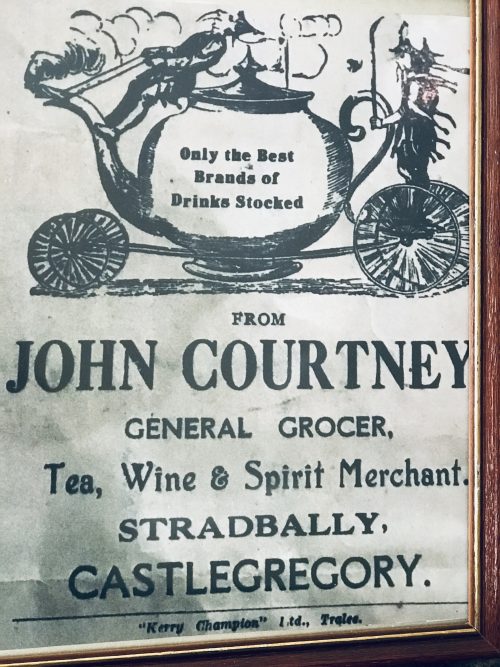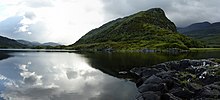
A 20-pack of Sweet Afton cigarettes with a text warning in both Irish and English stating "Smoking kills". |
|
| Product type | Cigarette |
|---|---|
-
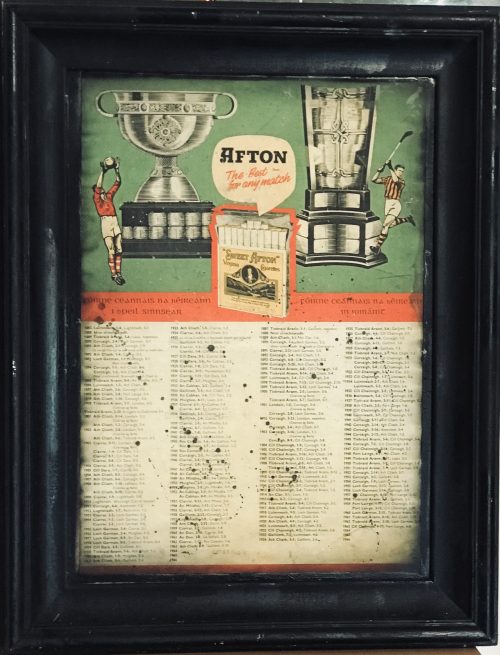 Fantastic original Sweet Afton Virginia Cigarettes Advertising print with beautiful images of the two holy grails in Irish Sport-The Sam Maguire Cup for the All Ireland Gaelic football Champions and the Liam McCarthy Cup for the All Ireland Hurling Champions.A footballer from Cork and a hurler from Kilkenny are featured in this charming print. Also the winners and shorelines from All Irelands from 1887 to 1963 are included underneath.Acharming addition to any wall space Dimensions: 75cm x 55cm Origins;Aughrim Co Galway UnglazedOrigins : Co Kilkenny Dimensions : 48cm x 62cmSweet Afton was an Irish brand of short, unfiltered cigarettes made with Virginia tobacco and produced by P.J. Carroll & Co., Dundalk, Ireland, now a subsidiary of British American Tobacco. The Sweet Afton brand was launched by Carroll's in 1919 to celebrate the link between Dundalk and the national poet of Scotland, Robert Burns. Burns' eldest sister, Agnes, lived in Dundalk from 1817 until her death in 1834 and was buried in the cemetery of St. Nicholas's Church in the town. Carroll's thought that the brand would only be successful in Scotland if the carton simply had an image of Burns, or Scottish name on the packet, so the people of Dundalk were canvassed and the name Sweet Afton was chosen. The name is taken from Burns' poem "Sweet Afton", which itself takes its title from the poem's first stanza: Flow gently, sweet Afton, amang thy green braes Flow gently, I’ll sing thee a song in thy praise My Mary’s asleep by they murmuring stream Flow gently, sweet Afton, disturb not her dream. A larger version of the cigarette was also marketed under the brand name Afton Major. This name served as inspiration for Carroll's later Majorbrand of tipped cigarettes. As of Autumn 2011, British American Tobacco no longer manufactures Sweet Afton cigarettes. The text "Thank you for your loyalty, unfortunately Sweet Afton will not be available in the future. However Major, our other Irish brand with similar tobacco will still be widely available for purchase." was written on a sticker that was put on the last line of packs, before it went out of production. The brand proved particularly popular with post World War II Rive Gauche Paris. It was reputed to be Jean-Paul Sartre's preferred cigarette, and also featured prominently in Louis Malle's film Le Feu Follet, as well as a number of other Nouvelle Vague films.Margot Tenenbaum (played by Gwyneth Paltrow) from Wes Anderson's 2001 film The Royal Tenenbaums also smokes Sweet Aftons. Thomas Shelby, in Peaky Blinders, smokes Sweet Aftons. They are also the favoured brand of Gerhard Selb, the eponymous private investigator in the trilogy by Bernhard SchlinkOld Afton advertisement on a pub in Wexford
Fantastic original Sweet Afton Virginia Cigarettes Advertising print with beautiful images of the two holy grails in Irish Sport-The Sam Maguire Cup for the All Ireland Gaelic football Champions and the Liam McCarthy Cup for the All Ireland Hurling Champions.A footballer from Cork and a hurler from Kilkenny are featured in this charming print. Also the winners and shorelines from All Irelands from 1887 to 1963 are included underneath.Acharming addition to any wall space Dimensions: 75cm x 55cm Origins;Aughrim Co Galway UnglazedOrigins : Co Kilkenny Dimensions : 48cm x 62cmSweet Afton was an Irish brand of short, unfiltered cigarettes made with Virginia tobacco and produced by P.J. Carroll & Co., Dundalk, Ireland, now a subsidiary of British American Tobacco. The Sweet Afton brand was launched by Carroll's in 1919 to celebrate the link between Dundalk and the national poet of Scotland, Robert Burns. Burns' eldest sister, Agnes, lived in Dundalk from 1817 until her death in 1834 and was buried in the cemetery of St. Nicholas's Church in the town. Carroll's thought that the brand would only be successful in Scotland if the carton simply had an image of Burns, or Scottish name on the packet, so the people of Dundalk were canvassed and the name Sweet Afton was chosen. The name is taken from Burns' poem "Sweet Afton", which itself takes its title from the poem's first stanza: Flow gently, sweet Afton, amang thy green braes Flow gently, I’ll sing thee a song in thy praise My Mary’s asleep by they murmuring stream Flow gently, sweet Afton, disturb not her dream. A larger version of the cigarette was also marketed under the brand name Afton Major. This name served as inspiration for Carroll's later Majorbrand of tipped cigarettes. As of Autumn 2011, British American Tobacco no longer manufactures Sweet Afton cigarettes. The text "Thank you for your loyalty, unfortunately Sweet Afton will not be available in the future. However Major, our other Irish brand with similar tobacco will still be widely available for purchase." was written on a sticker that was put on the last line of packs, before it went out of production. The brand proved particularly popular with post World War II Rive Gauche Paris. It was reputed to be Jean-Paul Sartre's preferred cigarette, and also featured prominently in Louis Malle's film Le Feu Follet, as well as a number of other Nouvelle Vague films.Margot Tenenbaum (played by Gwyneth Paltrow) from Wes Anderson's 2001 film The Royal Tenenbaums also smokes Sweet Aftons. Thomas Shelby, in Peaky Blinders, smokes Sweet Aftons. They are also the favoured brand of Gerhard Selb, the eponymous private investigator in the trilogy by Bernhard SchlinkOld Afton advertisement on a pub in Wexford -
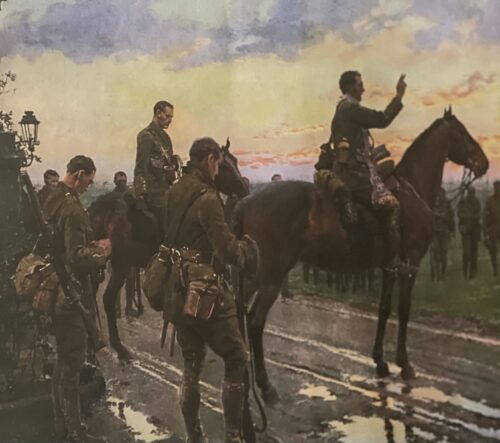
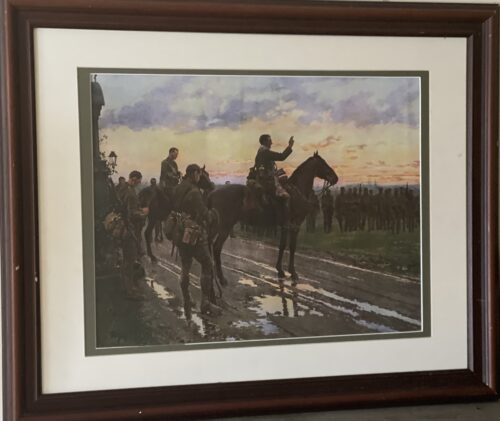 57cm x 70cm Co Tipperary
57cm x 70cm Co TipperaryThe most haunting and poignant image of Irish involvement in the first World War is at the centre of an unsolved art mystery.
The Last General Absolution of the Munsters at Rue du Bois – a painting long presumed lost – depicts soldiers of the Royal Munster Fusiliers regiment receiving “general absolution” from their chaplain on the eve of battle in May 1915. Most of them died within 24 hours.
The painting, by Italian-born war artist Fortunino Matania, became one of the most famous images of the war when prints of it were published in illustrated weekly newspapers.
Copies hung in houses & pubs throughout Ireland, and especially Munster, but, as Irish public opinion towards the war changed, the picture gradually disappeared from view.A copy still hangs in the famous pub Larkins of Garrykennedy Co Tipperary to this day.
Centenary commemorations of the first World War have prompted renewed interest in the whereabouts of the original painting among art and military historians.
A widely held theory that the painting was lost when archives were destroyed in a fire during the blitz of London in 1940 is “very much” doubted by English historian Lucinda Gosling, who is writing a book about the artist.
She told The Irish Times there was no definitive proof to confirm this theory and it was possible the original painting was still “out there”.
The painting could, conceivably, be in private hands or, more improbably, be lying forgotten or miscatalogued in a museum’s storage area. Matania’s work occasionally turns up at art auctions, but there has been no known or publicly-documented sighting of the original Munsters painting.
Ms Gosling described Matania as an artist “able to work at great speed, producing pictures that were unnervingly photographic in their realism”.
His pictures, she said, had “reached and influenced millions” and “he combined skill and artistry with a strong streak of journalistic tenacity”.
Wayside shrine
The painting is based on an event that took place on Saturday evening, May 8th, 1915.Soldiers from the Second Battalion, Royal Munster Fusiliers, commanded by Lieut-Col Victor Rickard, paused beside a wayside shrine near the village of Rue du Bois in northwest France. The following day, they were due to go into battle, in what became known as the Battle of Aubers Ridge.The painting is imbued with a sense of impending doom.
In Catholic canon law, a priest may grant general absolution of sin to a gathering of the faithful where there is imminent danger of death and no time for individual confessions.
The ritual was used on September 11th, 2001, in New York to grant general absolution to police officers and firefighters about to enter the Twin Towers of the World Trade Centre.In the painting, the Irish chaplain Fr Francis Gleeson is shown blessing the men: “Misereatur vestri omnipotens Deus; et dimissis omnibus peccatis vestris, perducat vos Iesus Christus ad vitam aeternam” (May Almighty God have mercy on you, and having forgiven all your sins, may Jesus Christ bring you to life everlasting).
The men then sang the hymns Te Deum and Hail Glorious St Patrick.
The artist was not present at the scene but based his painting on a written account by Lieut- Col Rickard’s widow, Jessie, who is believed to have commissioned the painting in memory of her husband.
She had gathered eye-witness accounts from survivors and wrote: “There are many journeys and many stopping- places in the strange pilgrimage we call life, but there is no other such journey in the world as the journey up a road on the eve of battle, and no stopping- place more holy than a wayside shrine.”
She noted among the troops were “lads from Kerry and Cork, who, a year before, had never dreamed of marching in the ranks of the British army”.
After Fr Gleeson’s blessing, she wrote: “The regiment moved on, and darkness fell as the skirl of the Irish pipes broke out, playing a marching tune.“The Munsters were wild with enthusiasm; they were strong with the invincible strength of faith and high hope, for they had with them the vital conviction of success, the inspiration that scorns danger – which is the lasting heritage of the Irish; theirs still and theirs to remain when great armaments and armies and empires shall be swept away, because it is immovable as the eternal stars.”
Mown down
The following morning, Sunday May 9th, most of the Irish soldiers were mown down by German gunfire and shelling.
On a catastrophic day for the British army – over 11,000 casualties – the Royal Munster Fusiliers suffered dreadful losses. Exact estimates vary, but one account records 800 Munsters went into battle and only 200 assembled that evening.
Mrs Rickard concluded : “So the Munsters came back after their day’s work; they formed up again in the Rue du Bois, numbering 200 men and three officers. It seems almost superfluous to make any further comment.”
The Last General Absolution of the Munsters at Rue du Bois
The Painting
The Last General Absolution of the Munsters at Rue du Bois shows some of the hundreds of soldiers from the second battalion of the Royal Munster Fusiliers who gathered at a shrine near the village of Rue du Bois on the western front on Saturday, May 8th, 1915.
The image was published in the London illustrated weekly newspaper The Sphere in November 1916, and in 1917 in the Weekly Freeman’s, an Irish publication. There are copies of the print in various museums and in private ownership in Ireland and Britain.
The Artist
Fortunino Matania, (1881- 1963) was born in Naples and was a well-known artist and illustrator in Italy before moving to London in 1902. He worked for The Sphere – an illustrated weekly newspaper – and became famous for depicting the sinking of the Titanic in 1912.
He was an official war artist in the first World War and his graphic illustrations of trench warfare were highly renowned.
The Location
Rue du Bois is located near the village of Neuve Chapelle in the Nord-Pas-de-Calais region of France close to the border with Belgium. According to the Royal Munster Fusiliers Association, the original shrine has long gone.
The Chaplain
Depicted on horseback, with hand raised granting general absolution, is Fr Francis Gleeson, a native of Templemore, Co Tipperary. He was ordained a priest in Maynooth in 1910 and volunteered to serve as a chaplain in the army at the outbreak of the war. He was assigned to the Royal Munster Fusiliers and served with distinction. He survived the war and returned to Ireland where he worked as priest in Dublin and died in 1959.
The Commanding Officer
Lieut-Col Victor Rickard, the other man on horseback, was born in Englandto an Irish father and English mother.
He was the commander of the battalion. He died in action the next day, aged 40.
The Patron
Lieut-Col Rickard’s widow Jessie, who is believed to have commissioned the painting, was the daughter of a Church of Ireland clergyman who spent her youth in Mitchelstown, Co Cork. She became a well-known novelist and published some 40 books.
After the war she converted to Catholicism under the guidance of another former chaplain in the British army in the first World War – Fr Joseph Leonard, who later befriended Jackie Kennedy.
Mrs Rickard died at Montenotte, Cork, in 1963, aged 86.
-


45cm x 34cm. Killarney Co Kerry
Theatrical advertising poster for "The way to Kenmare".Andrew Mack, born William Andrew McAloon, (July 25, 1863 – May 21, 1931) was an American vaudevillian, actor, singer and songwriter of Irish descent.A native of Boston, Massachusetts, he began his career at an early age in 1876 using the stage name Andrew Williams. He began in minstrel shows, and was especially associated with the song "A Violet From Mother's Grave".In 1892, he debuted in vaudeville. He composed songs for himself to sing. In 1899, he composed the popular song "The Story of the Rose (Heart of My Heart)" which became a standard of barbershop quartets.- Bluebeard's Seven Wives (1926)
-
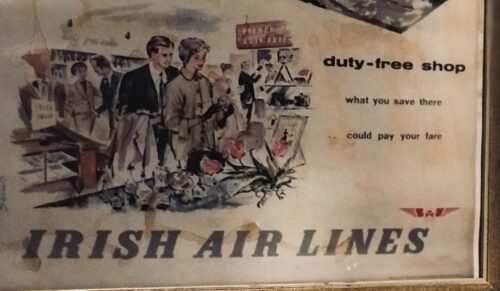
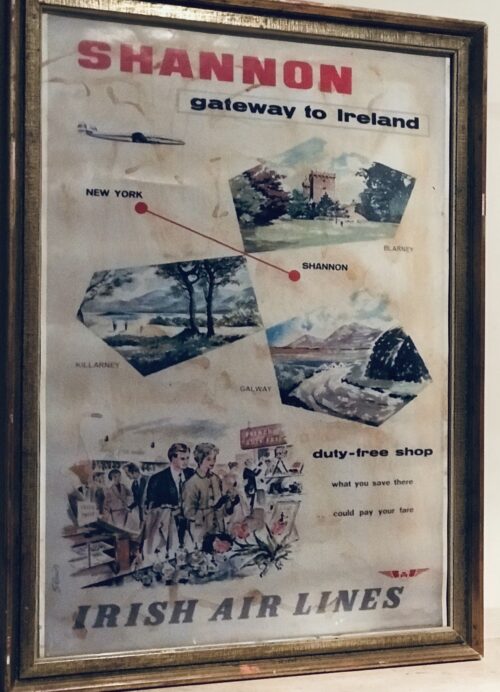
Worldwide Duty Free selling is a $70 billion business, but it has its origins in the mind of one Clare man. And like many innovations, the concept of duty free, which first came to Shannon Airport in 1952, was born of necessity.Today the global travel retail business is a firm fixture at airports across the world, and the concept has made a lot of money for a lot of people.But not for Brendan O’Regan, the man with the idea.
He was born into “the first generation of free Irish men” in relatively well-off surroundings in Sixmilebridge, Co Clare in 1917. His father, James, was chairman of Clare County Council and a successful businessman. The family was in the hotel business, and for a time leased the renowned Falls Hotel in Ennistymon and the Old Ground in Ennis. Sent as a boarder to Blackrock College in Dublin in 1931, O’Regan enjoyed early renown when he requested that the college, which by then had given up on the camán, field a hurling team in the Leinster Colleges cup.
His next step after school was training in hotel management, an interest that brought him to Germany, France and the UK, before coming home to run The Falls. He then moved to the ailing St Stephen’s Green club in Dublin, before being appointed catering comptroller at Foynes flying boat base in Co Limerick, then a refuelling point for transatlantic seaplanes.
It was here his passion for travel took off, but it was his next move that sealed his legacy.
Shannon Airport
Rineanna on the Shannon estuary in Co Clare, chosen by then taoiseach Seán Lemass as the site for a new airport for both sea and land planes, opened in October 1945, when the first transatlantic commercial air service from Boston landed there. It soon became Europe’s most important transatlantic airport, handling more than 100,000 passengers in 1946, its first full year of operation.
When O’Regan joined the nascent airport, its future was by no means secure. The imminent arrival of jet planes, which meant US planes would no longer have to stop in Shannon to refuel, was of concern, while the political apparatus of the day favoured focusing efforts on one airport in Dublin.
Fearing “economic annihilation” for the new airport, O’Regan sought a new venture that would help secure its future. Inspiration struck when he was returning home by sea from a visit to the United States, arranged under the Marshall Plan to allow the Irish government to study US tourism.
As told in the recently published book Brendan O’Regan: Irish Innovator, Visionary and Peacemaker by Brian O’Connell and Cian O’Carroll, O’Regan had a “eureka” moment on board.
“I saw the shop that was selling duty-free goods and my brain said to me: “If they can do it when you are crossing the sea in a boat, you can surely be able to do [it] when you land for the first time.”
He had to convince the Department of Industry and Commerce and the Revenue Commissioners of the merits of forgoing tax on the sale of goods, while local traders also opposed the move.
Nonetheless, O’Regan got the go-ahead and by July 1950 he had set up an operation in a timber hut outside the terminal, selling whiskey for $1.50 a bottle. The following year, the first duty-free shop in the world opened, with a bottle of whiskey on sale for just 30s, compared with 10s 6d in a regular shop, while in 1954 a mail order service was included. It went on to become a vast operation, mailing to locations all around the world, quality items such as crystal, china, fashionable clothing and jewellery.
Contagious idea
The concept soon caught on. In 1957 Amsterdam became the next airport to open a duty free, with the concept making its way across the Atlantic in 1962. Prince Philip was an early admirer of the concept, and he wanted it extended to all the UK’s international airports.
O’Regan also inspired philanthropist Chuck Feeney, who took the idea of duty free and galloped ahead with it, founding Duty Free Shoppers Group (DFS) in Hawaii in 1962, which later became the largest duty-free retailer in the world.
These years also saw the invention of Irish coffee, after O’Regan asked chef Joe Sheridan to “come up with something special” to warm up transatlantic passengers tired and cold after their trip.
But duty free was only part of the equation. O’Regan’s big dream was to position Shannon as the European manufacturing basis for US companies, and to bring employment and prosperity to the region.

Senator TK Whitaker, Brendan O’Regan (centre) and Dr Jerry Dempsey. Photograph: Peter Thursfield Shaped by the devastating impact poverty and emigration had on the county of his birth, O’Regan often repeated his father’s maxim, that “the most important thing about life is to create work for others, if you can”.
In the 1950s, the post-war boom that lifted the US, Europe and the UK had missed Ireland, and emigration was running at the highest level since independence.
So O’Regan didn’t stop at the duty free.
In 1951, he established the Shannon College of Hotel Management, which is still operating today and the graduates of which have managed the world’s top hotels, while he also leveraged the area’s potential as a tourist hub. He identified the potential of Bunratty Castle as a tourist attraction and, with the co-operation of its owner, Lord Gort, it was renovated and opened to the public in 1960, with the first medieval banquet held shortly thereafter. O’Regan later chaired Bord Fáilte.
Great times
“He was very much a leader and innovative in the sense that he thought up ideas himself,” recalls O’Carroll, who worked alongside O’Regan as estates manager in the Shannon Free Airport Development Company Limited (SFADCO). “He would work very intensively until the project was launched, and then he would go on to the next project”.
It was a time of “brainstorming picnics”, and consultancy reports, to try and hit on a new idea.
“They were great times,” says O’Carroll. “If an idea came up, and it was any way worthwhile, it would stand a very good chance of implementation.”
The big move came in the establishment of the Shannon Free Zone, the world’s first free trade zone, in 1959, overseen by SFADCO. It operated a licensing system, offering qualifying companies a corporation tax rate of just 10 per cent; a model that would later be taken up by the IFSC.
O’Regan’s idea, inspired by the Free Zone in Colon, Panama, was greeted with much scepticism initially, but his ability to build good relationships, particularly with those in government, helped secure the initiative.
“He had the ability to short-circuit a lot of things in terms of procedures in getting approval,” says O’Carroll, adding that “this clearly annoyed civil servants at the time.”
Indeed his initials, BOR, in Shannon came to mean “Bash on regardless”.
So, on an “if you build it they will come” ambition, SFADCO set about building factories – without any tenants. A Dutch piano manufacturer owned by Johan J Rippen was the first real enterprise to come to Shannon, followed by Sony, and diamond company De Beers in 1960.
Tourism smarts
O’Regan also ramped up the region’s renown as a tourist destination, using his tools of persuasion to garner investment.
When Bernard McDonough, a wealthy Irish-American industrialist pulled out of a planned ball-bearing factory in the Shannon Free Zone, O’Regan told him about a nearby castle that was for sale. He took the bait and bought it; in 1963 Dromoland Castle opened as a five-star hotel. McDonough would later open a further three hotels in the area.
When he heard of a plan by German investors to acquire the land leading to the Cliffs of Moher, he rang then Clare county manager Joe Boland, who subsequently got the county council to buy it.
During the 1970s he moved away from his formal roles in Shannon, and turned his attention to the peace process, founding Co-operation North (now Co-operation Ireland) in 1979. He died in 2008, and a bronze bust sculpture was unveiled at Shannon Airport in May 2017 to mark the centenary of his birth.
A man of his time – as O’Carroll recalls, an “infinitely simpler” time – he nonetheless left a significant legacy.
As described when receiving an honorary degree from the National University of Ireland in 1978: “Rare is the man of whom it can be justly said that he transformed the social, economic and industrial life of a whole region”
The Shannon project was not just about creating jobs; it was also about providing homes for the workers who flocked there.
By the late 1950s the housing issue, which had plagued the development of the hub since the early days, was becoming a crisis. So, in 1960, a proposal was tabled for the creation of a new town; an innovation without precedent in post-war Ireland.
Inspired by the British new towns that arose after the war, including Crawleyin Sussex and Stevenage in Hertfordshire, Brendan O’Regan and his team sought to build a new hub for workers of the airport and the industrial zone.
The creation of the first new town in the history of the State was not without challenges; there were political ructions as to who would oversee the project – the government or SFADCO – while residents of nearby Limerick city accused Brendan O’Regan of “empire building”, as they rued the fact that the development did not happen in Limerick instead.
Nonetheless, by 1962 the first residents were moving in, all of whom were tenants of SFADCO and who had to work either in the airport or industrial area to qualify for affordable housing.
As SFADCO estates manager Cian O’Carroll recalls, building the houses so close to a place of huge employment was key, as was the fact that units were small – but even larger families were catered for.
“We often let them two houses and knocked them together,” he says.
Also key to its success was the fact that housing was affordable, and graded and related to people’s incomes. After some time a tenant purchase scheme was introduced, allowing people to buy their homes outright.
Today the town is home to some 10,000 residents, and remains one of the few examples of a new planned town in Ireland.
“It hasn’t grown as much as people might have expected, but it has its own social and economic viability,” says O’Carroll.
As to why subsequent governments haven’t looked to emulate the success of Shannon – particularly given our housing shortages – O’Carroll suggests it’s due to an ideological shift away from the State doing things directly themselves, instead encouraging the private sector to do the same through tax incentives and other methods.
“It’s a shame,” he says.
-

 46cm x 48cm Cork Excellent original example of an original Great Southern & Western Railway sign warning the public against trespassing, otherwise finding themselves liable to the sizeable penalty of 40 shillings,By order of Francis B Ormsby.The Great Southern & Western Railway was an Irish gauge railway company founded in 1844 until it was wound up in the Free State that existed ins 1924.It became the largest of Irelands Big 4 railway networks and at its peak it had an 1100 mile network, of which 240 miles were double track.The most heavily used existing routes of today ,linking Dublin with Cork,Limerick and Waterford are all old GS&WR routes and the coats of arms of these cities adorn the facade of Hueston Station Dublin,formerly Kingsbridge Station until it was renamed in 1966.
46cm x 48cm Cork Excellent original example of an original Great Southern & Western Railway sign warning the public against trespassing, otherwise finding themselves liable to the sizeable penalty of 40 shillings,By order of Francis B Ormsby.The Great Southern & Western Railway was an Irish gauge railway company founded in 1844 until it was wound up in the Free State that existed ins 1924.It became the largest of Irelands Big 4 railway networks and at its peak it had an 1100 mile network, of which 240 miles were double track.The most heavily used existing routes of today ,linking Dublin with Cork,Limerick and Waterford are all old GS&WR routes and the coats of arms of these cities adorn the facade of Hueston Station Dublin,formerly Kingsbridge Station until it was renamed in 1966. -
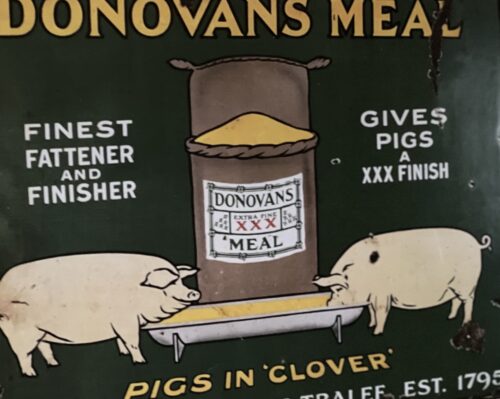
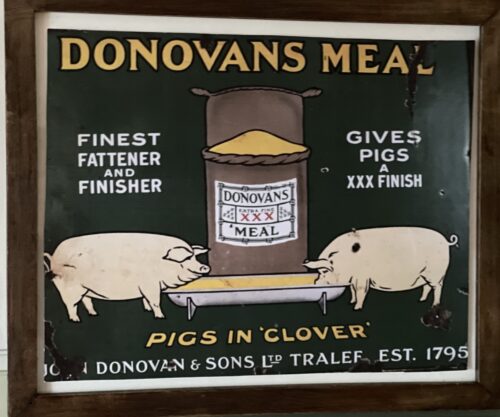 45cm x 35cm I got this piece of interesting information from ‘The Unquiet Grave‘, The Development of Kerry’s Burial Grounds through the Ages – that very interesting book edited by Michael Connolly for Kerry County Council. The chapter on A Tale of Two Tombs tells the fascinating story of the rise and fall of the Donovan family of Tralee, who were wealthy merchants in the town through three generations in 1800’s. Some of you will remember that the Donovans also owned the Jeanie Johnston, which was the Donovan’s most important ship carrying emigrants on the outward journey to Quebec and bringing cargoes of timber back on the return voyage. John Donovan was the founding father and set up a hardware business initially in the Square, Tralee and then branched out leasing and owning shipping bringing iron, coal and slate to Tralee. His sons Nicholas and Henry followed him, they also became the leading political as well as the leading merchants in the town. There is a brilliant description of John’s funeral . He died in 1864 when he was 82 and we are told ‘All the stops were pulled out for the full pageantry of Victorian obsequies’. The Kerry Evening Post reported ‘an unusual grief had fallen upon the town’. According to the same newspaper there were 174 carriages, and there was an important extra little detail -‘the majority were drawn by two horses’ – a two-horse carriage indicated greater social standing than a one-horse carriage’ Try and get hold of this very interesting book from the County Council or log on here for the digital version. And were there any women there at all? Yes, but they were there with a purpose – to provide the all important keening that was then the expected norm at all funerals of all classes. At this funeral we are told ‘The poor of the town, beneficiaries of John Donovan’s generosity, congregated outside the house in The Square, and when the coffin was removed to the hearse, they set up an immense keening, which they continued as they followed the funeral all the way to Ballyseedy’. Another interesting fact relating to women and their own funerals at this time was that ‘while men were buried in the middle of the day, the women, on the other hand were buried early in the morning, regardless of the time of year’. John Donovan’s own wife Catherine was buried in the dark at 6am on a February morning and Nicholas’ wife was buried at the same time in December 1878. ‘Only Henry’s wife was buried in daylight and that was because the burial was at 8am on an August morning in 1885. The higher status of men was constantly affirmed. We have come a long way!
45cm x 35cm I got this piece of interesting information from ‘The Unquiet Grave‘, The Development of Kerry’s Burial Grounds through the Ages – that very interesting book edited by Michael Connolly for Kerry County Council. The chapter on A Tale of Two Tombs tells the fascinating story of the rise and fall of the Donovan family of Tralee, who were wealthy merchants in the town through three generations in 1800’s. Some of you will remember that the Donovans also owned the Jeanie Johnston, which was the Donovan’s most important ship carrying emigrants on the outward journey to Quebec and bringing cargoes of timber back on the return voyage. John Donovan was the founding father and set up a hardware business initially in the Square, Tralee and then branched out leasing and owning shipping bringing iron, coal and slate to Tralee. His sons Nicholas and Henry followed him, they also became the leading political as well as the leading merchants in the town. There is a brilliant description of John’s funeral . He died in 1864 when he was 82 and we are told ‘All the stops were pulled out for the full pageantry of Victorian obsequies’. The Kerry Evening Post reported ‘an unusual grief had fallen upon the town’. According to the same newspaper there were 174 carriages, and there was an important extra little detail -‘the majority were drawn by two horses’ – a two-horse carriage indicated greater social standing than a one-horse carriage’ Try and get hold of this very interesting book from the County Council or log on here for the digital version. And were there any women there at all? Yes, but they were there with a purpose – to provide the all important keening that was then the expected norm at all funerals of all classes. At this funeral we are told ‘The poor of the town, beneficiaries of John Donovan’s generosity, congregated outside the house in The Square, and when the coffin was removed to the hearse, they set up an immense keening, which they continued as they followed the funeral all the way to Ballyseedy’. Another interesting fact relating to women and their own funerals at this time was that ‘while men were buried in the middle of the day, the women, on the other hand were buried early in the morning, regardless of the time of year’. John Donovan’s own wife Catherine was buried in the dark at 6am on a February morning and Nicholas’ wife was buried at the same time in December 1878. ‘Only Henry’s wife was buried in daylight and that was because the burial was at 8am on an August morning in 1885. The higher status of men was constantly affirmed. We have come a long way! -
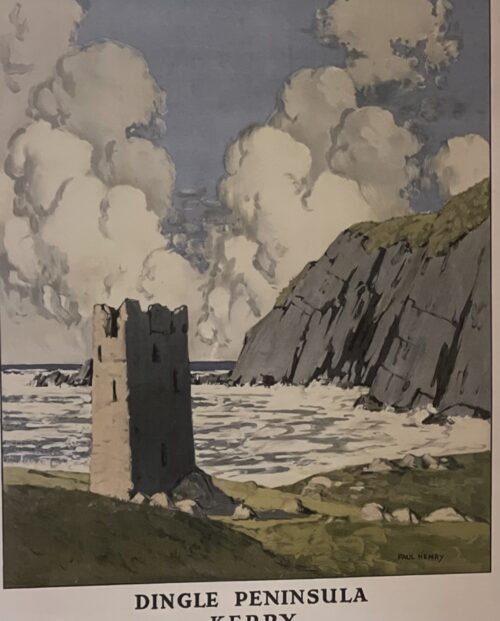
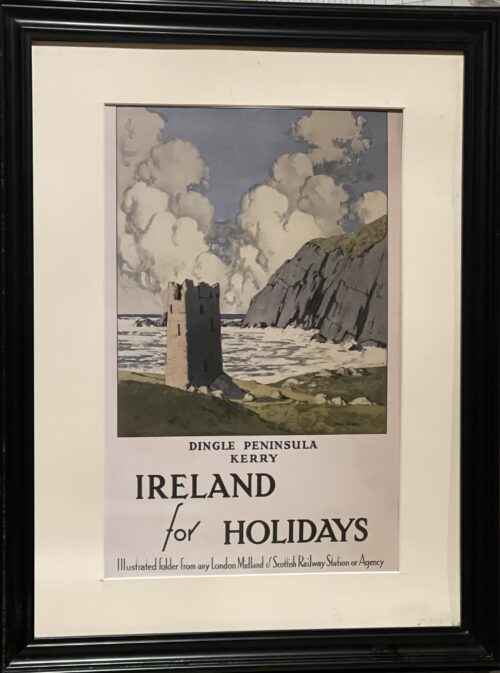 52cm x 44cm The London, Midland and Scottish Railway (LMS) was a British railway company. It was formed on 1 January 1923 under the Railways Act of 1921,which required the grouping of over 120 separate railways into four. The companies merged into the LMS included the London and North Western Railway, Midland Railway, the Lancashire and Yorkshire Railway (which had previously merged with the London and North Western Railway on 1 January 1922), several Scottish railway companies (including the Caledonian Railway), and numerous other, smaller ventures. Besides being the world's largest transport organisation, the company was also the largest commercial enterprise in the British Empire and the United Kingdom's second largest employer, after the Post Office. In 1938, the LMS operated 6,870 miles (11,056 km) of railway (excluding its lines in Northern Ireland), but its profitability was generally disappointing, with a rate of return of only 2.7%. Under the Transport Act 1947, along with the other members of the "Big Four" British railway companies (Great Western Railway, London and North Eastern Railway and Southern Railway), the LMS was nationalised on 1 January 1948, becoming part of the state-owned British Railways. The LMS was the largest of the Big Four railway companies serving routes in England, Northern Ireland, Scotland and Wales. The LMS's commercial success in the 1920s resulted in part from the contributions of English painter, Norman Wilkinson. In 1923, Wilkinson advised Superintendent of Advertising and Publicity of the LMS, T.C Jeffrey, to improve rail sales and other LMS services by incorporating fine art into the design of their advertisement posters. In this time, fine art already had a distinguished association in Europe and North America with good taste, longevity and quality.[26] Jeffrey wanted LMS’ commercial image to align with these qualities and therefore accepted Wilkinson's advice.[27] For the first series of posters, Wilkinson personally invited 16 of his fellow alumni from the Royal Academy of London to take part. In letter correspondence, Wilkinson outlined the details of the LMS proposal to the artists.The artist fee for each participant was £100. The railway poster would measure 50 X 40 inches. In this area, the artist's design would be reproduced as a photolithographic print on double royal satin paper, filling 45 X 35 inches. The mass-produced posters were pasted inside railway stations in England, Northern Ireland, Scotland and Wales. LMS decided the subject advertised, but choices of style and approach were left to the artist's discretion. LMS’ open design brief resulted in a collection of posters that reflected the large capacity of destinations and experiences available with the transport organisation.For the Irish Free State, Wilkinson designed a poster in 1927 encouraging the public to avail of the LMS ferry and connecting boat trains to Ireland. For this promotion, Wilkinson's design was accompanied with four posters of Ireland by Belfast modernist painter, Paul Henry. The commercial success of Wilkinson and Jeffrey's collaboration manifested between 1924 and 1928, with public sale of 12,000 railway posters.Paul Henry's 1925 poster depicting the Gaeltacht region of Connemara in County Galway proved most commercially popular, with 1,500 sales. Paul Henry (11 April 1876 – 24 August 1958) was an Irish artist noted for depicting the West of Ireland landscape in a spare Post-Impressioniststyle. Henry was born at 61 University Road, Belfast, Ireland, the son of the Rev Robert Mitchell Henry, a Baptist minister (who later joined the Plymouth Brethren), and Kate Ann Berry. Henry began studying at Methodist College Belfast in 1882 where he first began drawing regularly. At the age of fifteen he moved to the Royal Belfast Academical Institution.He studied art at the Belfast School of Art before going to Paris in 1898 to study at the Académie Julian and at Whistler's Académie Carmen. He married the painter Grace Henry in 1903 and returned to Ireland in 1910. From then until 1919 he lived on Achill Island, where he learned to capture the peculiar interplay of light and landscape specific to the West of Ireland. In 1919 he moved to Dublin and in 1920 was one of the founders of the Society of Dublin Painters, originally a group of ten artists. Henry designed several railway posters, some of which, notably Connemara Landscape, achieved considerable sales.He separated from his wife in 1929. His second wife was the artist Mabel Young. In the 1920s and 1930s Henry was Ireland's best known artist, one who had a considerable influence on the popular image of the west of Ireland. Although he seems to have ceased experimenting with his technique after he left Achill and his range is limited, he created a large body of fine images whose familiarity is a testament to its influence. Henry's use of colour was affected by his red-green color blindness.He lost his sight during 1945 and did not regain his vision before his death. A commemorative exhibition of Henry's work was held at Trinity College, Dublin, in 1973 and the National Gallery of Ireland held a major exhibition of his work in 2004. A painting by Henry was featured on an episode of the BBC's Antiques Roadshow, broadcast on 12 November 2006. The painting was given a value of approximately £40,000–60,000 by the roadshow. However, due to the buoyancy of the Irish art market at that time, it sold for €260,000 on 5 December 2006 in James Adams' and Bonhams' joint Important Irish Art sale. He died at his home at 1 Sidmonton Square, Bray, County Wicklow, and was survived by his wife, Mabel.
52cm x 44cm The London, Midland and Scottish Railway (LMS) was a British railway company. It was formed on 1 January 1923 under the Railways Act of 1921,which required the grouping of over 120 separate railways into four. The companies merged into the LMS included the London and North Western Railway, Midland Railway, the Lancashire and Yorkshire Railway (which had previously merged with the London and North Western Railway on 1 January 1922), several Scottish railway companies (including the Caledonian Railway), and numerous other, smaller ventures. Besides being the world's largest transport organisation, the company was also the largest commercial enterprise in the British Empire and the United Kingdom's second largest employer, after the Post Office. In 1938, the LMS operated 6,870 miles (11,056 km) of railway (excluding its lines in Northern Ireland), but its profitability was generally disappointing, with a rate of return of only 2.7%. Under the Transport Act 1947, along with the other members of the "Big Four" British railway companies (Great Western Railway, London and North Eastern Railway and Southern Railway), the LMS was nationalised on 1 January 1948, becoming part of the state-owned British Railways. The LMS was the largest of the Big Four railway companies serving routes in England, Northern Ireland, Scotland and Wales. The LMS's commercial success in the 1920s resulted in part from the contributions of English painter, Norman Wilkinson. In 1923, Wilkinson advised Superintendent of Advertising and Publicity of the LMS, T.C Jeffrey, to improve rail sales and other LMS services by incorporating fine art into the design of their advertisement posters. In this time, fine art already had a distinguished association in Europe and North America with good taste, longevity and quality.[26] Jeffrey wanted LMS’ commercial image to align with these qualities and therefore accepted Wilkinson's advice.[27] For the first series of posters, Wilkinson personally invited 16 of his fellow alumni from the Royal Academy of London to take part. In letter correspondence, Wilkinson outlined the details of the LMS proposal to the artists.The artist fee for each participant was £100. The railway poster would measure 50 X 40 inches. In this area, the artist's design would be reproduced as a photolithographic print on double royal satin paper, filling 45 X 35 inches. The mass-produced posters were pasted inside railway stations in England, Northern Ireland, Scotland and Wales. LMS decided the subject advertised, but choices of style and approach were left to the artist's discretion. LMS’ open design brief resulted in a collection of posters that reflected the large capacity of destinations and experiences available with the transport organisation.For the Irish Free State, Wilkinson designed a poster in 1927 encouraging the public to avail of the LMS ferry and connecting boat trains to Ireland. For this promotion, Wilkinson's design was accompanied with four posters of Ireland by Belfast modernist painter, Paul Henry. The commercial success of Wilkinson and Jeffrey's collaboration manifested between 1924 and 1928, with public sale of 12,000 railway posters.Paul Henry's 1925 poster depicting the Gaeltacht region of Connemara in County Galway proved most commercially popular, with 1,500 sales. Paul Henry (11 April 1876 – 24 August 1958) was an Irish artist noted for depicting the West of Ireland landscape in a spare Post-Impressioniststyle. Henry was born at 61 University Road, Belfast, Ireland, the son of the Rev Robert Mitchell Henry, a Baptist minister (who later joined the Plymouth Brethren), and Kate Ann Berry. Henry began studying at Methodist College Belfast in 1882 where he first began drawing regularly. At the age of fifteen he moved to the Royal Belfast Academical Institution.He studied art at the Belfast School of Art before going to Paris in 1898 to study at the Académie Julian and at Whistler's Académie Carmen. He married the painter Grace Henry in 1903 and returned to Ireland in 1910. From then until 1919 he lived on Achill Island, where he learned to capture the peculiar interplay of light and landscape specific to the West of Ireland. In 1919 he moved to Dublin and in 1920 was one of the founders of the Society of Dublin Painters, originally a group of ten artists. Henry designed several railway posters, some of which, notably Connemara Landscape, achieved considerable sales.He separated from his wife in 1929. His second wife was the artist Mabel Young. In the 1920s and 1930s Henry was Ireland's best known artist, one who had a considerable influence on the popular image of the west of Ireland. Although he seems to have ceased experimenting with his technique after he left Achill and his range is limited, he created a large body of fine images whose familiarity is a testament to its influence. Henry's use of colour was affected by his red-green color blindness.He lost his sight during 1945 and did not regain his vision before his death. A commemorative exhibition of Henry's work was held at Trinity College, Dublin, in 1973 and the National Gallery of Ireland held a major exhibition of his work in 2004. A painting by Henry was featured on an episode of the BBC's Antiques Roadshow, broadcast on 12 November 2006. The painting was given a value of approximately £40,000–60,000 by the roadshow. However, due to the buoyancy of the Irish art market at that time, it sold for €260,000 on 5 December 2006 in James Adams' and Bonhams' joint Important Irish Art sale. He died at his home at 1 Sidmonton Square, Bray, County Wicklow, and was survived by his wife, Mabel. -
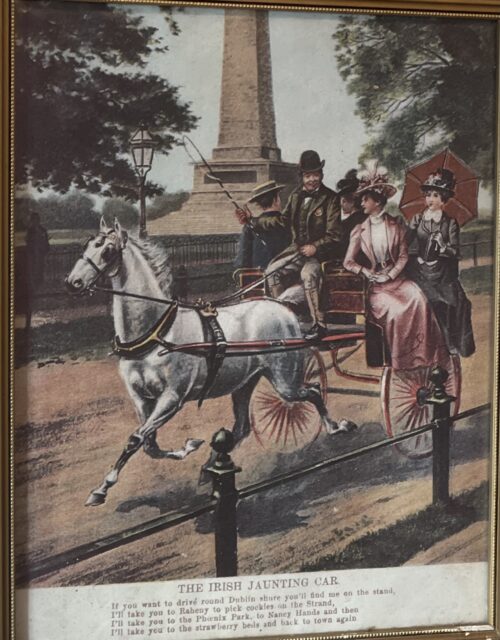
 58cm x 42cm Quaint vintage poster of a jaunting car carrying a group around Phoenix Park- the giant Wellington monument can be seen in the background. The Wellington Monument or sometimes the Wellington Testimonial,is an obelisk located in the Phoenix Park, Dublin, Ireland. The testimonial is situated at the southeast end of the Park, overlooking Kilmainham and the River Liffey. The structure is 62 metres (203 ft) tall, making it the largest obelisk in Europe
58cm x 42cm Quaint vintage poster of a jaunting car carrying a group around Phoenix Park- the giant Wellington monument can be seen in the background. The Wellington Monument or sometimes the Wellington Testimonial,is an obelisk located in the Phoenix Park, Dublin, Ireland. The testimonial is situated at the southeast end of the Park, overlooking Kilmainham and the River Liffey. The structure is 62 metres (203 ft) tall, making it the largest obelisk in EuropeHistory
The Wellington Testimonial was built to commemorate the victories of Arthur Wellesley, 1st Duke of Wellington. Wellington, the British politician and general, also known as the 'Iron Duke', was born in Ireland. Originally planned to be located in Merrion Square, it was built in the Phoenix Park after opposition from the square's residents. The obelisk was designed by the architect Sir Robert Smirke and the foundation stone was laid in 1817. In 1820, the project ran out of construction funds and the structure remained unfinished until 18 June 1861 when it was opened to the public. There were also plans for a statue of Wellington on horseback, but a shortage of funds ruled that out.Features
There are four bronze plaques cast from cannons captured at Waterloo – three of which have pictorial representations of his career while the fourth has an inscription. The plaques depict 'Civil and Religious Liberty' by John Hogan, 'Waterloo' by Thomas Farrell and the 'Indian Wars' by Joseph Robinson Kirk. The inscription reads:- Asia and Europe, saved by thee, proclaim
- Invincible in war thy deathless name,
- Now round thy brow the civic oak we twine
- That every earthly glory may be thine.
Cultural references
The monument is referenced throughout James Joyce's Finnegans Wake. The first page of the novel alludes to a giant whose head is at "Howth Castle and Environs" and whose toes are at "a knock out in the park (p. 3)"; John Bishop extends the analogy, interpreting this centrally located obelisk as the prone giant's male member. A few pages later, the monument is the site of the fictional "Willingdone Museyroom" (p. 8). -

 Very unusual Tourist advertisement for Killarney commissioned by the Great |Southern Railway company enticing well heeled holidaymakers to make their way to Killarney from Kingsbridge (now Hueston Station) 55cm x 45cm Tralee Co Kerry The Lakes of Killarney are a scenic attraction located in Killarney National Park near Killarney, County Kerry, in Ireland. They consist of three lakes - Lough Leane, Muckross Lake (also called Middle Lake) and Upper Lake. The lakes sit in a low valley some 20 m (66 ft) above sea level. They are surrounded by the rugged slopes of MacGillycuddy's Reeks. Notable mountains in the range include Carrauntoohil, which, at 1,038 metres (3,406 ft) is Ireland's highest mountain, Purple Mountain, at 832 metres (2,730 ft), Mangerton Mountain, at 843 metres (2,766 ft), and Torc Mountain, at 535 metres (1,755 ft). The N71 road from Killarney to Kenmare passes a viewpoint called Ladies View which offers a view of the lakes and valleys. On the occasion of Queen Victoria's visit in 1861, the point was apparently chosen by the queen's ladies-in-waiting as the finest in the land; hence the name.
Very unusual Tourist advertisement for Killarney commissioned by the Great |Southern Railway company enticing well heeled holidaymakers to make their way to Killarney from Kingsbridge (now Hueston Station) 55cm x 45cm Tralee Co Kerry The Lakes of Killarney are a scenic attraction located in Killarney National Park near Killarney, County Kerry, in Ireland. They consist of three lakes - Lough Leane, Muckross Lake (also called Middle Lake) and Upper Lake. The lakes sit in a low valley some 20 m (66 ft) above sea level. They are surrounded by the rugged slopes of MacGillycuddy's Reeks. Notable mountains in the range include Carrauntoohil, which, at 1,038 metres (3,406 ft) is Ireland's highest mountain, Purple Mountain, at 832 metres (2,730 ft), Mangerton Mountain, at 843 metres (2,766 ft), and Torc Mountain, at 535 metres (1,755 ft). The N71 road from Killarney to Kenmare passes a viewpoint called Ladies View which offers a view of the lakes and valleys. On the occasion of Queen Victoria's visit in 1861, the point was apparently chosen by the queen's ladies-in-waiting as the finest in the land; hence the name.Lough Leane
Lough Leane (from Irish Loch Léin, meaning 'lake of learning') is the largest and northernmost of the three lakes, approximately 19 square kilometres (4,700 acres) in size. It is also the largest body of fresh water in the region. The River Laune drains Lough Leane to the north-west towards Killorglinand into Dingle Bay. Leane is dotted with small forested islands, including Innisfallen Island, which holds the remains of the ruined Innisfallen Abbey.On the eastern edge of the lake, Ross Island, more properly a peninsula, was the site of some of the earliest Copper Age metalwork in prehistoric Ireland.Ross Castle, a 15th-century keep, sits on the eastern shore of the lake, north of the Ross Island peninsula.Muckross Lake
Also known as Middle Lake or Torc Lake, Muckross is just south of Lough Leane. The two are separated by a small peninsula, crossed by a stone arched bridge called Brickeen Bridge. It is Ireland's deepest lake, reaching to 75 metres (246 ft) in parts.A paved hiking trail of approximately 10 km (6.2 mi) circles the lake.Upper Lake
The Upper Lake is the smallest of the three lakes, and the southernmost. It is separated from the others by a winding channel some 4 km (2.5 mi) long.Gallery
-
Hand-drawn map of the Lakes by French artist Alphonse Dousseau, between 1830-1869
-
Photograph of Upper Lake by Fergus O’Connor circa 1920 with commotion in bottom right


